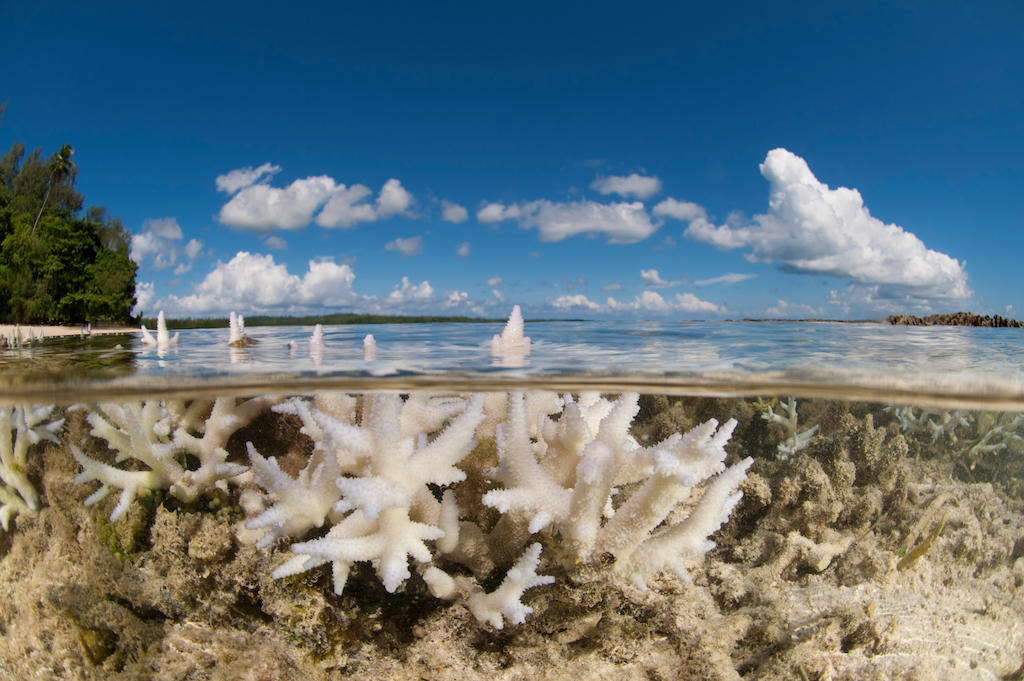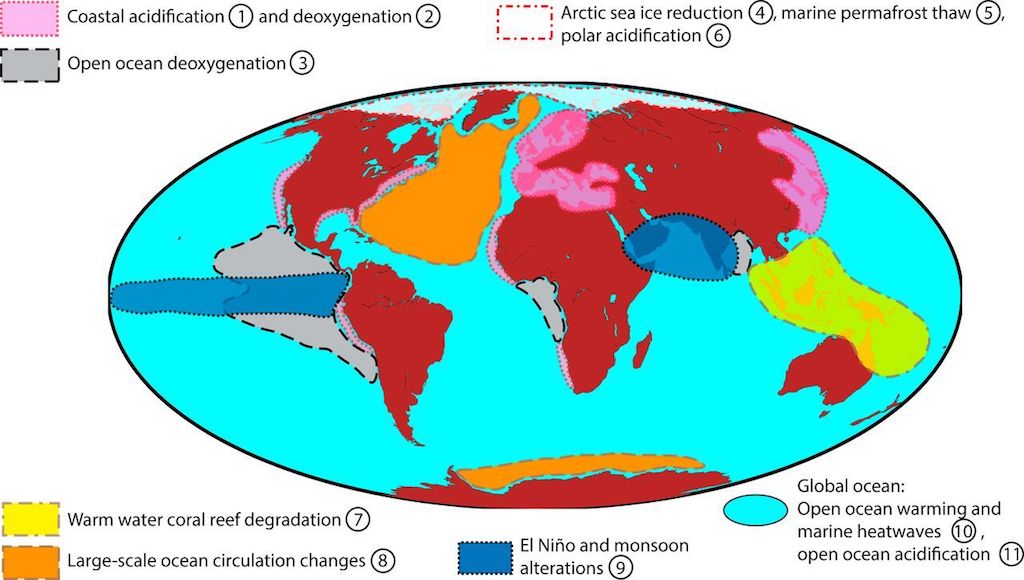
Guest post: The threat of high-probability ocean ‘tipping points’

Dr Helena Martins
02.23.21
Dr Helena Martins
23.02.2021 | 3:49pmClimate change is profoundly altering our oceans and marine ecosystems. Some of these changes are happening quickly and are potentially irreversible. Many are taking place silently and unnoticed.
In recent years, tipping points – thresholds where a small change could push a system into a completely new state – have increasingly become a focus for the climate research community.
However, these are typically thought of in terms of unlikely changes with huge global ramifications – often referred to as “low probability, high impact” events. Examples include the slowdown of the Atlantic Meridional Overturning Circulation and the rapid disintegration of the West Antarctic ice sheet.
In a new paper, published in the Proceedings of the National Academy of Sciences, my co-authors and I instead focus on the potential for what we call “high probability, high impact” tipping points caused by the cumulative impact of warming, acidification and deoxygenation.
We present the challenge of dealing with these imminent and long-lasting changes in the Earth system, and discuss options for mitigation and management measures to avoid crossing these tipping points.
Warming, acidification and deoxygenation
The ocean is a giant reservoir of heat and carbon. Since the beginning of the industrial revolution, the oceans have taken up around 30-40% of the carbon dioxide (CO2) and 93% of the heat added to the atmosphere through human activity.
Without ocean uptake, the scale of atmospheric warming would already be much larger. But this comes with a high cost in the form of ocean warming, acidification – where the alkaline ocean becomes more acidic – and deoxygenation – where the oxygen content of the ocean falls.
The potential impact of these processes on the marine environment is well documented. However, in some cases, they could trigger a number of regional tipping points with potentially widespread consequences for marine ecosystems and ocean functioning.
Here are some examples:
Warming
Each species has an optimal temperature range for their physiological functioning. Like humans, most marine organisms are vulnerable to warming above their optimal temperature. Without adaptation, some species will be hit hard by ocean warming. A well-known example is the threat to tropical coral reef systems, such as Australia’s Great Barrier Reef, to mass coral bleaching from extreme heat.

These coral reef systems play an important role for fisheries, for coastal protection, as fish nurseries, and for a number of other ecosystem services. This serves as an example of how the impact of ocean warming extends far beyond the most sensitive marine organisms, with range shifts being observed across the food web from phytoplankton to marine mammals.
Deoxygenation
Most marine organisms can only exist in seawater with sufficiently high concentrations of dissolved oxygen. Warming of the ocean decreases the solubility of oxygen in the water and slows down ocean mixing, which, in turn, decreases oxygen transport from the surface into the ocean interior.
In addition, run-off of nutrients from the land – such as from agriculture and domestic waste – increases the biological productivity in coastal areas, disrupting ecosystems and enhancing deoxygenation. Consequences for marine organisms are huge, with species distribution, growth, survival and ability to reproduce negatively affected.
Acidification
Besides being the primary driver of global warming, CO2 also changes ocean chemistry, causing the acidification of seawater. Many marine organisms have shells or skeletal structures made of mineral forms particularly vulnerable to ocean acidification. A well-known example are pteropods – free-swimming sea snails and sea slugs – that live in the upper 10 metres of the ocean, which are a keystone species in the marine food web.
Currently observed acidification conditions are already unprecedented within the last 65m years, and are projected to continue and aggravate for many centuries even with the reduction of carbon emissions to net-zero.
High-probability, high-impact ocean tipping points
While these different processes are individually a danger to marine life, in combination with other threats – such as overfishing, high nutrient input from land and invasive species – they have the potential to cause ecosystem-wide regime shifts.
In addition, extreme events – such as marine heatwaves or high-acidity, low-oxygen events – lead to severe consequences for marine biodiversity. Across the globe, the observed local and regional changes already add up to a substantial regional – and possibly global – problem. Examples include coastal acidification and anoxic ocean “dead zones”.
The figure below highlights some of the regions of the world ocean that are under threat from these impacts.

While these impacts already need dealing with today, ocean circulation patterns mean that they are also being stored up for the future.
The upper ocean mixes on a timescale of decades, while the deep ocean water masses are renewed from the surface on a much longer timescale – from hundreds to thousands of years. The present-day accumulation of heat and carbon are initially largest at the ocean surface. But, through mixing and ocean currents, this excess of heat and carbon is transported away from the surface and into deeper layers.
These short and long-term timescales have two consequences. The first is that mixing is not fast enough to prevent the accumulation of heat and carbon in the upper ocean.
The second is that deep mixing transports some of the surface excess heat and carbon to greater depths, where long-lasting changes can gradually build up. Consequently, the deep ocean can be altered by climate change irreversibly for thousands of years, even under strong emission reduction scenarios. These impacts are incredibly difficult to monitor at such depths.
Can these ocean tipping points be avoided?
While the threats to the ocean from human-caused climate change are many and varied, there is still time for them to be minimised. We highlight a few action points where scientists are contributing to the development and implementation of mitigation actions.
First, scientists are using models and observations to determine the regions where the most severe hazards have occurred, are occurring, and may occur in the future. Laboratory and in-situ experiments can help identify vulnerabilities in organisms and ecosystems.
Second, progress is being made to define important thresholds in the physiological tolerance of key organisms for changes in temperature, oxygen concentration, nutrient levels and acidity. This also draws attention to the need for metrics of global change that go beyond atmospheric CO2 concentration and global average surface temperature. Keeping a close watch on potential ocean tipping points means tracking ocean temperature changes, acidification, deoxygenation and marine productivity.
Third, communication of these threats is improving. While there is still much progress to be made – for example, in building climate and ocean literacy and working with indigenous groups – research into empowering science communication to address global challenges is growing.
While headway is being made, much more action is needed. We suggest four system management and societal transformation actions for minimising the likelihood of encountering high-probability, high-impact ocean tipping points:
- The highest priority for ocean damage limitation is the immediate and drastic reduction of greenhouse gas emissions – particularly CO2.
- To achieve emission reductions, human societies need to shift to a decarbonised energy production, sustainable use of land and ocean, and climate-friendly urban and regional planning.
- The implementation of mitigation measures needs to be enabled through adequate governance structures and seamless interagency action.
- And, finally, these transformations need to be carried out increasingly fast.
Heinze, C. et al. (2021) The quiet crossing of ocean tipping points, Proceedings of the National Academy of Sciences, doi:10.1073/pnas.2008478118
This work received funding from the European Union’s Horizon 2020 research and innovation programme under grant agreement No. 820989. The contents of this article reflect only the author’s views – the European Commission and their executive agencies are not responsible for any use that may be made of the information it contains.

